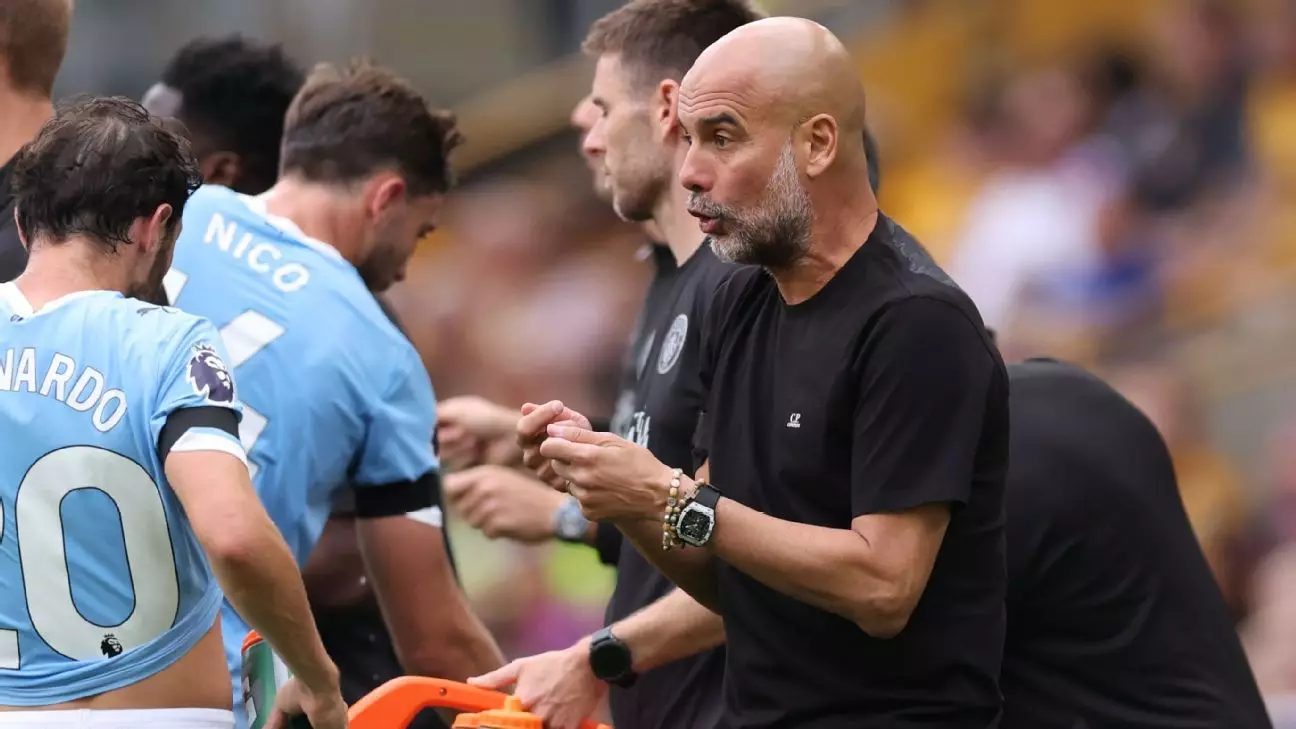Manchester City’s commanding 4-0 victory over Wolves in their opening league clash was a statement of intent. The team exuded confidence, displaying dynamic attacking prowess led by the prolific Erling Haaland, who netted twice. New signings Tijjani Reijnders and Rayan Cherki made impressive debuts, suggesting that City’s transfer strategy is aligned with their relentless pursuit of dominance. Yet, beneath this impressive start lies a more complex narrative—one that exposes internal challenges that could threaten the club’s internal harmony and long-term stability.
Guardiola’s team demonstrated near-flawless transition play and tactical discipline, capitalizing on Wolves’ defensive lapses. Their ability to swiftly counterattack underscores the team’s strategic planning and physical conditioning. However, this spectacular opening visually masks a strategic issue: the squad size and player management. City’s immense depth is both an asset and a liability, as the club grapples with maintaining harmony within a congested squad.
Squad Oversaturation and the Quest for Balance
While a deep squad theoretically offers resilience across multiple competitions, Guardiola’s candid frustration with the current roster size reveals a less discussed concern—team chemistry and morale. Guardiola’s remark that the squad is “not healthy” isn’t merely about numbers but signals a deeper worry rooted in player satisfaction and the club’s future planning.
Having a surplus of players creates a delicate environment, risking discord or complacency. It hinders the development of young talent who may feel sidelined and fosters an atmosphere where players could become unsettled. Guardiola’s emphasis on integrating every player into the squad-building fabric signifies his desire for a cohesive unit, yet the number of players clamoring for game time complicates this vision.
Guardiola’s approach—trying to offload excess talent within two weeks—demonstrates a proactive mindset, though the process will undoubtedly test the club’s negotiation skills and patience. The risk is that in trying to streamline the squad, City might unsettle key players or miss out on strategic signings, all while trying to retain a competitive edge.
Genuine Uncertainty Surrounding Key Players
Brian “Trafford” Traffords’ solid debut was a bright spot, yet the focus on goalkeeping tensions underlines a more serious issue: uncertainty surrounding Ederson’s future. The Brazilian stopper’s relevance remains a central question, especially with rumors linking City to Gianluigi Donnarumma. Guardiola’s public defense of Ederson emphasizes loyalty and certainty, but his illness and the ongoing speculation reflect the fragility of squad stability at this level.
The club’s stance on Ederson’s potential departure underscores their strategic stance. Guardiola’s line—that if a player seeks a move, it’s ultimately the club’s decision—resonates with the pragmatic reality of modern football: player loyalty is numerically and emotionally fragile. As negotiations unfold, City must weigh the benefits of maintaining squad cohesion versus acquiring new talent who may bring uncertainty or disruption.
This scenario exemplifies the broader issue facing top-tier clubs: balancing long-term planning with immediate performance. Guardiola, known for his tactical flexibility, must also navigate the often unpredictable human elements of squad management—an intricate dance that can shift rapidly depending on transfers and player sentiments.
Implications for the Season Ahead
From a tactical perspective, Guardiola’s commentary on the first-half performance shows optimism tempered with realism. Although the team punished Wolves effectively through quick transitions—highlighting their attacking potential—he acknowledges flaws that need correction. This humility signals that City’s journey toward a seventh Premier League title in nine seasons remains a work in progress, not a fait accompli.
The emergence of Reijnders as a key asset from the start reflects Guardiola’s confidence in youth and new signings. However, integrating new players into a cohesive system while managing a congested squad will be the true test of City’s managerial acumen. The coach clearly values pace and transition but recognizes the need for consistency and tactical refinement as the season progresses.
Meanwhile, Wolves’ outsider perspective hints at the possibility that City’s dominance might sometimes mask vulnerabilities—technical, tactical, or psychological—that opponents will aim to exploit. The early-season optimism must be balanced with vigilance and adaptability if City hopes to sustain their lofty ambitions.
Without a doubt, Manchester City’s season will be shaped by their ability to resolve internal issues, manage player relations delicately, and harness their attacking depth effectively. Guardiola’s challenge goes beyond tactics; it revolves around weaving a harmonious team fabric that can withstand the rigors of a competitive campaign with its inevitable setbacks and curveballs. Success, in this context, doesn’t merely rest on star power but on strategic patience, human insight, and relentless pursuit of excellence.

